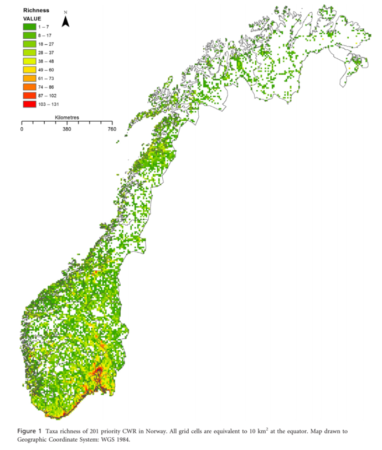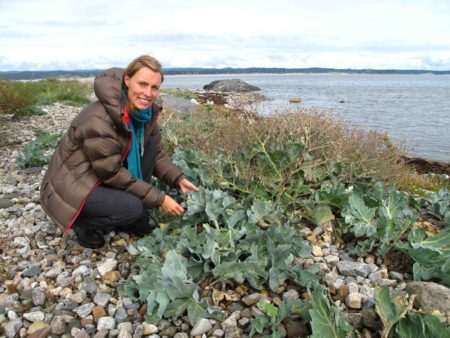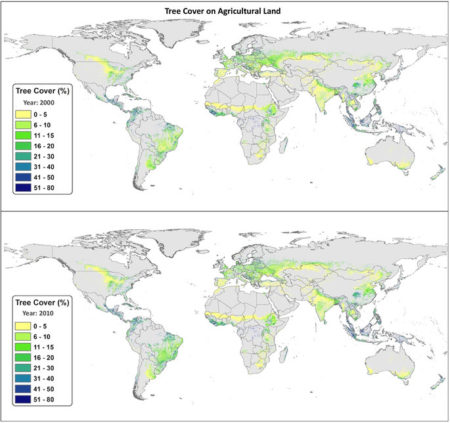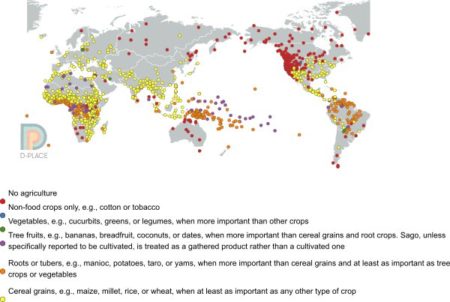- Ancient seeds put on life support. Not holding my breath.
- Key Biodiversity Areas to be mapped. Agrobiodiversity also? Not holding my breath.
- Botany on reality TV? Not holding my breath. No, wait…
- More on the ICARDA story. Holding my breath.
- Kofi Annan on that “uniquely African Green Revolution.” Not holding my breath, but here’s the latest report on how AGRA is doing. Oh, and there’s more on Africa, from IFPRI this time.
- A caterpillar on the Silk Road. Now, that I’d like to see.
- But not before coffee.
Home is where conservation begins
Thanks to Jade Philips (see her on fieldwork below) and Åsmund Asdal, two of the authors, for contributing this post on their recent paper on the conservation of crop wild relatives in Norway.
![]() Norway may be an unlikely spot in which to look for agrobiodiversity, but seek and ye shall find. A recent paper discusses the development and implementation of an in situ and ex situ conservation strategy for priority crop wild relatives (CWR) in the country. 1 Some 204 taxa were prioritized, which included forage species, berries, vegetables and herbs. Distribution data collected from GBIF and species distribution modelling software including MaxEnt and the CAPFITOGEN tools were used to identify conservation priorities.
Norway may be an unlikely spot in which to look for agrobiodiversity, but seek and ye shall find. A recent paper discusses the development and implementation of an in situ and ex situ conservation strategy for priority crop wild relatives (CWR) in the country. 1 Some 204 taxa were prioritized, which included forage species, berries, vegetables and herbs. Distribution data collected from GBIF and species distribution modelling software including MaxEnt and the CAPFITOGEN tools were used to identify conservation priorities.
 A proposal was made for a network of in situ genetic reserves throughout Norway to help capture the genetic diversity of priority CWR and allow them to evolve along with environmental changes. Some 10% of priority species do not seem to be found in existing protected areas.
A proposal was made for a network of in situ genetic reserves throughout Norway to help capture the genetic diversity of priority CWR and allow them to evolve along with environmental changes. Some 10% of priority species do not seem to be found in existing protected areas.
Complementary ex situ priorities were also set out in the paper to ensure the full range of ecogeographic diversity across Norway, and hence genetic diversity, was captured within genebanks and therefore easily available for plant pre-breeders and breeders to utilise. Some 177 species have no ex situ collections at all. The priority CWR identified and the methodology used within Norway are applicable both in other countries and internationally. We hope that now the scientific basis for the conservation of these vital resources within Norway has been identified, integration of these recommendations into current conservation plans will begin. This will take us one step closer to the systematic global protection and use of our wild agrobiodiversity, a need which is growing increasingly urgent each day.

Brainfood: Lentil diversity, Cacao diversity, Larch distribution, Tea diversity, Salmon breeding, Ethiopian sorghum, Brassica differentiation, Biodiversity info, Human footprint
- Genetic Diversity of Cultivated Lentil (Lens culinaris Medik.) and Its Relation to the World’s Agro-ecological Zones. 352 accessions, 54 countries, 3 agro-ecological groups (South Asia, Mediterranean, N temperate) in USDA collection.
- Association mapping of seed and disease resistance traits in Theobroma cacao L. 6 and 1 markers, respectively, based on 483 unique trees in the International Cocoa Genebank, Trinidad (ICGT).
- Historic translocations of European larch (Larix decidua Mill.) genetic resources across Europe – A review from the 17th until the mid-20th century. Humans have moved material to areas outside its native distribution, and have mixed up genetically distinct populations in some places.
- Insights into the Genetic Relationships and Breeding Patterns of the African Tea Germplasm (Camellia sinensis (L.) O. Kuntze) Based on nSSR Markers and cpDNA Sequences. African material groups according to where it was bred.
- First the seed, next the smolt? Will salmon farmers learn the right lessons from plant biotechnology? I bet not.
- Geographic patterns of phenotypic diversity in sorghum (Sorghum bicolor (L.) Moench) landraces from North Eastern Ethiopia. There aren’t any. Patterns, that is.
- Subgenome parallel selection is associated with morphotype diversification and convergent crop domestication in Brassica rapa and Brassica oleracea. Similar heading and tuberous morphotypes in the two species are due to parallel selection on genes that diverged after duplication event.
- Assessing the Cost of Global Biodiversity and Conservation Knowledge. Golly, it’s expensive!
- Sixteen years of change in the global terrestrial human footprint and implications for biodiversity conservation. Human footprint hasn’t increased by as much as might be feared, but still extends over 75% of world’s land surface. Let the mashing up with crop wild relatives hotspots begin!
Brainfood: Ryegrass genome, Pest distributions, German oregano, Pápalos distribution, Chinese pea, Dutch cattle, Animal biobanking, Legumes everywhere, Crop diversification in China, Asian fermentation
- An ultra-high density genetic linkage map of perennial ryegrass (Lolium perenne) using genotyping by sequencing (GBS) based on a reference shotgun genome assembly. Zzzzzzz.
- Future Risks of Pest Species under Changing Climatic Conditions. We’re doomed.
- Antioxidant capacity variation in the oregano (Origanum vulgare L.) collection of the German National Genebank. It’s huge. Fantastic. The best variation you’ve ever seen, I guarantee it.
- The distribution of cultivated species of Porophyllum (Asteraceae) and their wild relatives under climate change. New one on me.
- Biodiversity analysis in the digital era. Using the Atlas of Living Australia as an example.
- Large-scale evaluation of pea (Pisum sativum L.) germplasm for cold tolerance in the field during winter in Qingdao. 214 out of 3672, mainly coming from, wait for it, the winter production regions.
- Conservation priorities for the different lines of Dutch Red and White Friesian cattle change when relationships with other breeds are taken into account. 5 out of 7 genetic lines don’t need to be conserved.
- Domesticated Animal Biobanking: Land of Opportunity. “…journals should apply the same standard to samples and associated data, as they currently apply to molecular data, in terms of storage in formalized repositories prior to publication.”
- Neglecting legumes has compromised human health and sustainable food production. Includes nice summary of genebank holdings, using Genesys as a source of information.
- Crop Diversity and Land Simplification Effects on Pest Damage in Northern China. Diversity to the rescue. But…
- Ethnic Fermented Foods and Alcoholic Beverages of Japan. Just one chapter in a whole book on fermentation in Asia.
Agroforestry around the world
I’ve been looking for an excuse to play around with the Database of Places, Language, Culture and Environment (D-PLACE), which “contains cultural, linguistic, environmental and geographic information for over 1400 human ‘societies’”. It finally arrived today, in the form of a monumental study of carbon sequestration on farmland in Nature. The authors used remote sensing and fancy spatial modelling to work out the amount of tree cover, and hence the levels of biomass carbon, on agricultural land around the world. This is the global map they got for % tree cover in 2000 and 2010.

I was curious to see whether one could predict the areas of highest tree cover (or highest biomass C) from the much coarser data on agriculture that D-PLACE brings together from ethnographic studies. This is what the distribution of “major crop type” looks like, from D-PLACE.

So the answer is no, I guess. It’s difficult to see any association between the amount of trees on farms and the main types of crops grown there, at least just by eyeballing the maps. There may be a hint of a preference for roots and tubers, but nothing really jumps out. I’ll keep playing though, there’s a whole range of cultural and ecological variables you can tweak.